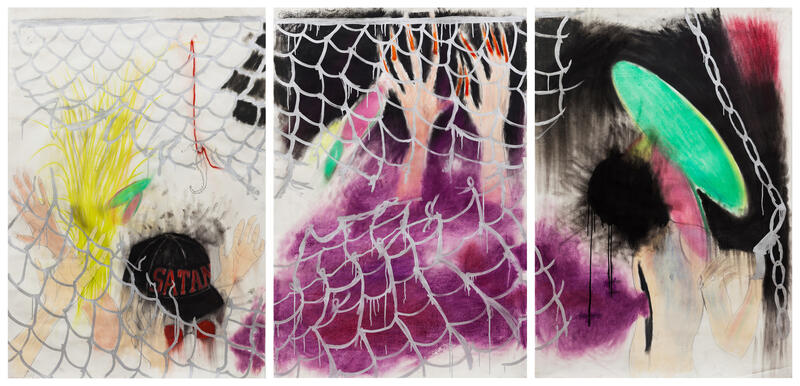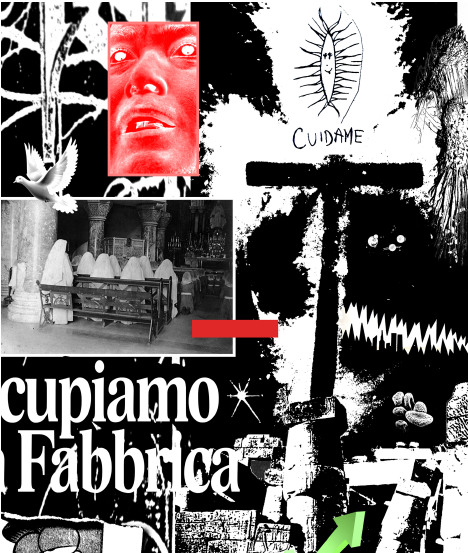Scarlet placenta: Nicanor Aráoz at Barro
From March 28th to April 28th, an exhibition by Argentinean artist Nicanor Aráoz will be presented at Barro Gallery.

In a fragment of the text of the exhibition, Nicolas Cuello says:
[...] The construction of Gothic environments can be thought of as an obsessive insistence that has slowly been perfected in the work of Aráoz. This energy is characterized by being a form of imagination that operates by pressing on the tensions that organize reality: its expressive language is the symptomatic torment that results from historical and hysterical antagonisms that rub together the good and the bad, the healthy and the sick, the permissible and the perverse, the crime and the law, the repressive control of forms and the monstrous abundance of the deformed. From its origins, as well as the occult sciences and underground cultures, this principle of Gothic representation can be thought of as a passionate way of investigating the boundaries of meaning, on the margins of the law, but especially on the moorings that restrict ability to re-imagine what is alive. The evolution of his work can even be thought of as a clear maturing process where the question of this emotional matrix of turbulence articulates new questions: at first those objects of everyday order that were captured by the dryness of the embalming gave rise to the appearance of bodies dismembered sculptures with which he has investigated not only the monstrous condition of time but also the cultural marks of violence from an aesthetic that ties unconnected fragments of popular culture, graphic design and fashion, with the deformed temperatures of the dystopian time sci- fi.
[...] The construction of Gothic environments can be thought of as an obsessive insistence that has slowly been perfected in the work of Aráoz. This energy is characterized by being a form of imagination that operates by pressing on the tensions that organize reality: its expressive language is the symptomatic torment that results from historical and hysterical antagonisms that rub together the good and the bad, the healthy and the sick, the permissible and the perverse, the crime and the law, the repressive control of forms and the monstrous abundance of the deformed. From its origins, as well as the occult sciences and underground cultures, this principle of Gothic representation can be thought of as a passionate way of investigating the boundaries of meaning, on the margins of the law, but especially on the moorings that restrict ability to re-imagine what is alive. The evolution of his work can even be thought of as a clear maturing process where the question of this emotional matrix of turbulence articulates new questions: at first those objects of everyday order that were captured by the dryness of the embalming gave rise to the appearance of bodies dismembered sculptures with which he has investigated not only the monstrous condition of time but also the cultural marks of violence from an aesthetic that ties unconnected fragments of popular culture, graphic design and fashion, with the deformed temperatures of the dystopian time sci- fi.
But in this new opportunity, without doubt we are facing the articulation of a new strange desire in that expressive will of a thousand languages that the shadow offers. We are facing the presence of a desire that investigates a new opportunity for the future, carved from the viscerality of turbulent emotions, from confused feelings and negative utopias. An answer, perhaps, that rehearses itself on the remains of Glótica (2016) its last exhibition in the Barro gallery, where it pushed to the limit of the escópica explosion its curiosity for the corporal resonances of the damage. Scarlet Placenta can be thought of as a strange environment in which the inevitable promise of a new crooked future is finally conjured, a dark room that retains the most intense moment of a ritual composed of a mob of bestial bodies in motion that desperately seek the new destructive incarnation of freedom, that signal that guides the dizzy arrow of an intoxicated reverie among the remnants of a reality absorbed by the knots of the repressive and that finally warns us that we have arrived at the prompt inauguration of the dome of pleasure.
To enter into this space implies, in some way, getting involved in the deployment of the forces of the heretical, becoming not only a participatory agent in this transpersonal call to the hidden forces of a perverse future, but also finding belonging to that herd of animalized beings whose punk sensitivity builds a possible place for alchemical trauma experimentation.
As a devotee who is intoxicated by the promise of confused feelings and engages in the infectious multiplication of the occult, Nicanor Aráoz reveals to us in this obscene chamber a new investigation, which in front of the icy fire of neon, shares the passionate strength that he visits him in secret, that torments him and pushes him to pronounce the most beautiful spell in the history of the night, the one that stubbornly asks about the possibility of a new life.
-
 Nicanor Aráoz, Placenta Escarlata, 2018 Barro (detalle de instalación).
Nicanor Aráoz, Placenta Escarlata, 2018 Barro (detalle de instalación).




